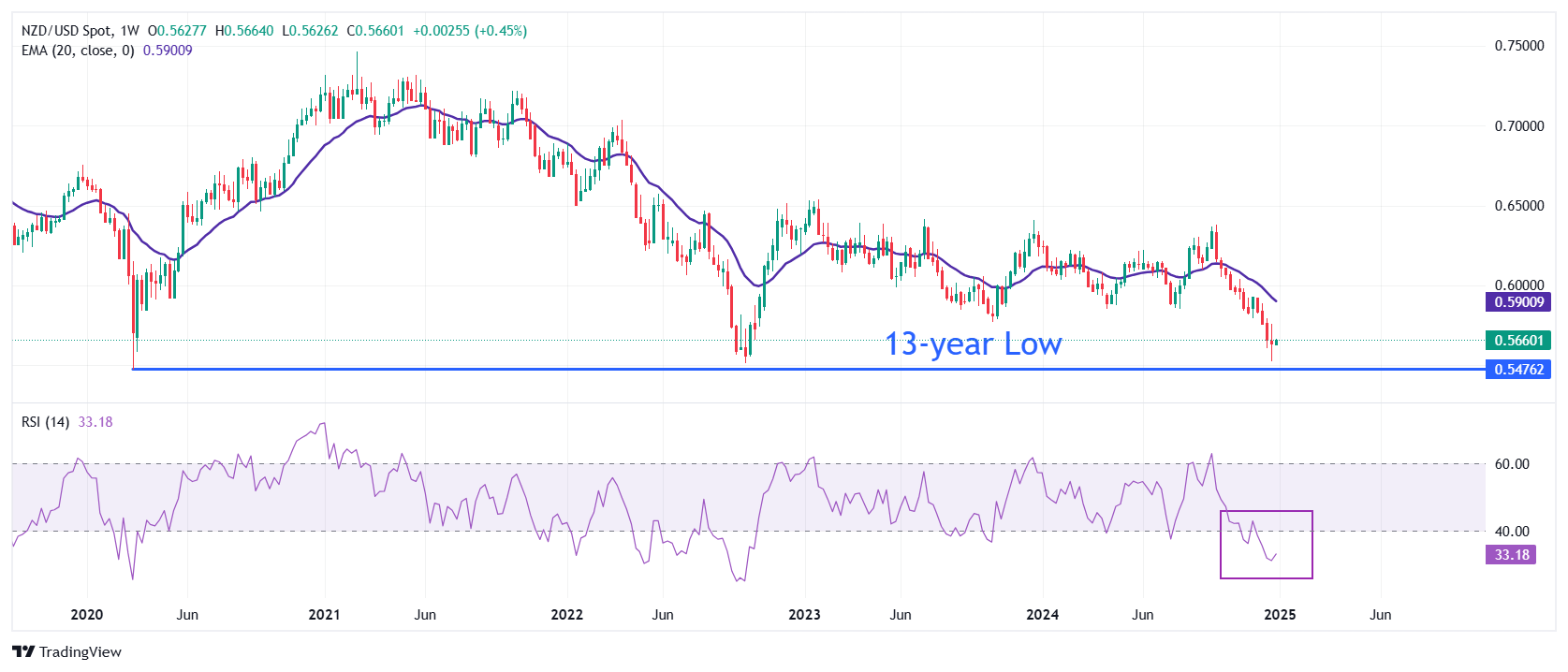- NZD/USD jumps above 0.5650 after China vowed to boost private consumption.
- Investors await China’s official business activity data for December.
- The RBNZ is expected to cut interest rates by 50 bps in February.
The NZD/USD pair climbs to near 0.5660 in Monday’s European session. The Kiwi pair gains sharply after the Chinese government announced measures to boost private consumption. China’s central government stated that it would offer handouts to people struggling with the cost of living and vowed more benefits for some unemployed people, Xinhua News agency reported.
Going forward, investors will focus on China’s National Bureau of Statistics (NBS) Manufacturing and Non-Manufacturing Purchasing Managers’ Index (PMI) data for December, which will be released on Tuesday. The economic data is expected to show that the Manufacturing PMI expanded steadily to 50.3, while the non-manufacturing output grew slightly faster to 50.2.
Being a close trading partner of China, the New Zealand Dollar (NZD) is impacted by Chinese economic activity data.
However, the broader outlook for the Kiwi dollar remains weak. Investors are confident that the Reserve Bank of New Zealand (RBNZ) will cut its Official Cash Rate (OCR) again by 50 basis points (bps) to 3.75% in the February policy meeting.
Meanwhile, the US Dollar (USD) drops on a broadly quiet trading day ahead of New Year celebrations. The US Dollar Index (DXY), which tracks the Greenback’s value against ix major currencies, falls to near 107.85.
NZD/USD finds a temporary cushion near the two-year low of 0.5520 on a weekly timeframe. The outlook of the Kiwi pair remains bearish as the 20-week Exponential Moving Average (EMA), which trades around 0.5900.
The 14-week Relative Strength Index (RSI) slides to near 30.00, suggesting a strong bearish momentum.
If it breaks below the psychological support of 0.5500, the Kiwi pair could decline to near the 13-year low of 0.5470 and the round-level support of 0.5400.
On the other hand, a decisive break above the November 29 high of 0.5930 could drive the pair to the November 15 high of 0.5970 and the psychological resistance of 0.6000.
NZD/USD weekly chart

New Zealand Dollar FAQs
The New Zealand Dollar (NZD), also known as the Kiwi, is a well-known traded currency among investors. Its value is broadly determined by the health of the New Zealand economy and the country’s central bank policy. Still, there are some unique particularities that also can make NZD move. The performance of the Chinese economy tends to move the Kiwi because China is New Zealand’s biggest trading partner. Bad news for the Chinese economy likely means less New Zealand exports to the country, hitting the economy and thus its currency. Another factor moving NZD is dairy prices as the dairy industry is New Zealand’s main export. High dairy prices boost export income, contributing positively to the economy and thus to the NZD.
The Reserve Bank of New Zealand (RBNZ) aims to achieve and maintain an inflation rate between 1% and 3% over the medium term, with a focus to keep it near the 2% mid-point. To this end, the bank sets an appropriate level of interest rates. When inflation is too high, the RBNZ will increase interest rates to cool the economy, but the move will also make bond yields higher, increasing investors’ appeal to invest in the country and thus boosting NZD. On the contrary, lower interest rates tend to weaken NZD. The so-called rate differential, or how rates in New Zealand are or are expected to be compared to the ones set by the US Federal Reserve, can also play a key role in moving the NZD/USD pair.
Macroeconomic data releases in New Zealand are key to assess the state of the economy and can impact the New Zealand Dollar’s (NZD) valuation. A strong economy, based on high economic growth, low unemployment and high confidence is good for NZD. High economic growth attracts foreign investment and may encourage the Reserve Bank of New Zealand to increase interest rates, if this economic strength comes together with elevated inflation. Conversely, if economic data is weak, NZD is likely to depreciate.
The New Zealand Dollar (NZD) tends to strengthen during risk-on periods, or when investors perceive that broader market risks are low and are optimistic about growth. This tends to lead to a more favorable outlook for commodities and so-called ‘commodity currencies’ such as the Kiwi. Conversely, NZD tends to weaken at times of market turbulence or economic uncertainty as investors tend to sell higher-risk assets and flee to the more-stable safe havens.






